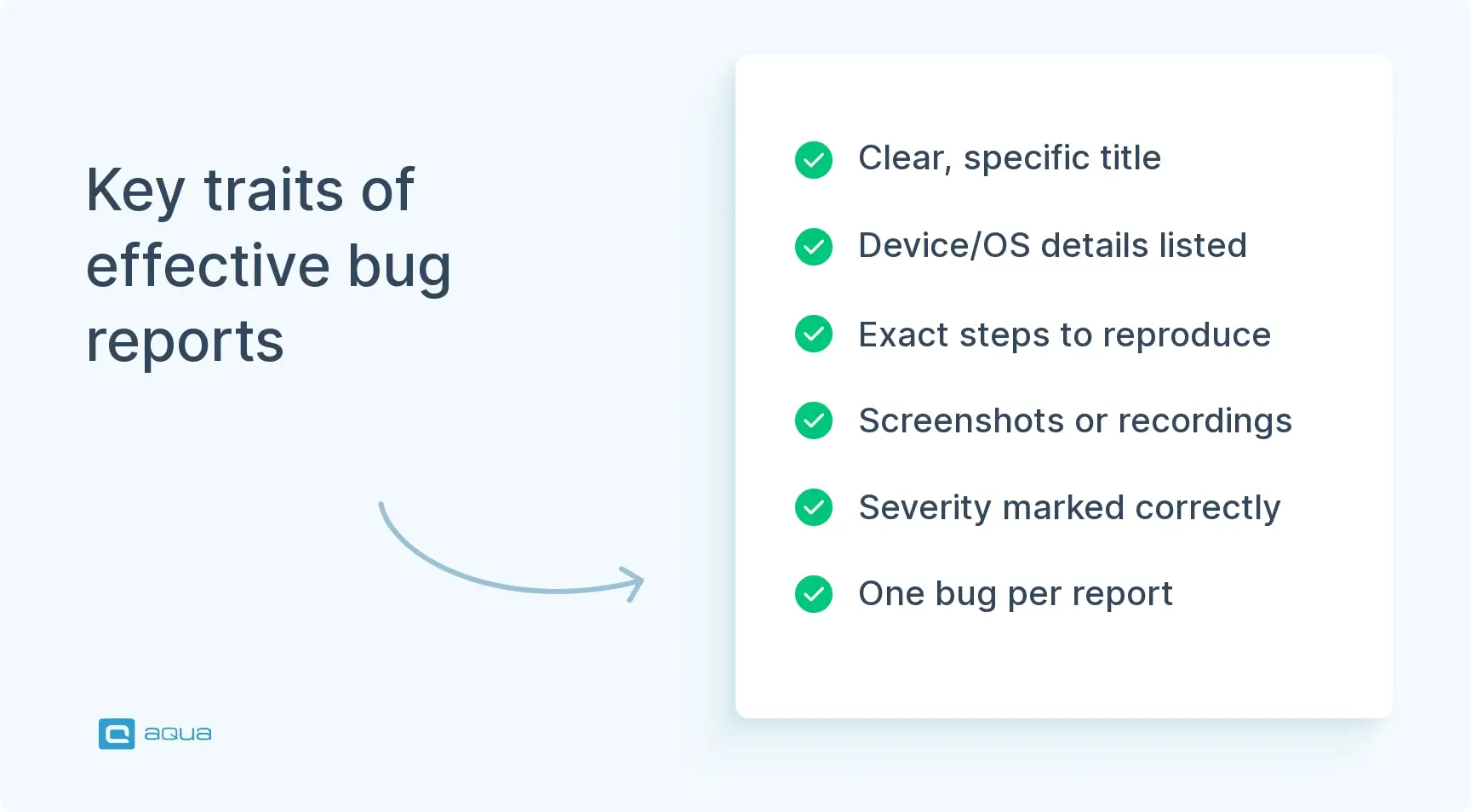Key Takeaways
- Effective mobile app bug reporting requires clear reproduction steps, complete environment details, visual evidence, and accurate severity assessment to enable quick resolution without back-and-forth clarification.
- Modern in-app bug reporting SDKs capture diagnostic data automatically (logs, screenshots, device info) reducing resolution time by up to 40% compared to manual reporting methods.
- User-submitted bug reports through in-app channels can reduce negative app store reviews by 80% while providing valuable real-world testing coverage that internal QA teams miss.
- AI-powered bug tracking tools now automate categorization, detect duplicates, and predict issue severity, allowing teams to focus on fixes rather than manual triage work.
- Successful bug reporting combines detailed documentation, collaborative tools, prompt communication, and closed feedback loops with users who report issues.
Tired of bug reports that waste time with missing details and endless clarifications? Learn how to create actionable mobile app bug reports that developers can fix immediately 👇
The Importance of Bug Reporting in Mobile App Development
Understanding why mobile bug reporting matters starts with what happens when it fails. A user opens your app on their Samsung Galaxy running Android 13, hits a crash, and immediately uninstalls. They never tell you about it. You never see the bug report. That user is just gone, along with any revenue they might have generated.
Mobile users are ruthless about this. Desktop users might tolerate a buggy application because switching costs are high. They’ve invested time in setup, saved data locally, or don’t want to find alternatives. Mobile users delete apps the way most people skip songs they don’t like. One freeze, one crash, one battery drain problem, and you’re off their phone.
The data backs this up. Research shows that 78% of people encounter bugs in mobile apps regularly, and most will ditch an app that keeps having problems. Your competitor’s app is literally one tap away in the app store. This makes bug reporting less of a quality assurance nicety and more of a survival mechanism.
Here’s where it gets tricky for mobile specifically. A bug might only happen on certain devices, with certain OS versions, under certain network conditions. Traditional bug reporting approaches that work fine for desktop software fall apart when you’re dealing with hundreds of hardware and software combinations. You need reports that capture the mobile-specific context automatically, or you’ll spend more time trying to reproduce issues than fixing them.
If you figure this out, you see the difference immediately. Faster fixes, fewer repeat issues, better app store ratings. More importantly, you can actually move fast with releases because you trust your bug reporting system will catch problems before those problems reach most users. Without that trust, every release feels like a gamble.
Characteristics of an Ideal Bug Report
Knowing why bug reporting matters is one thing. Knowing how to actually write a report that gets fixed is another. The difference between a bug that gets addressed in hours versus one that rots in your backlog for months usually comes down to what information you include. Let’s break down those characteristics in a practical manner.
Clear, Specific Title
Start with a title that actually describes the problem. “App crashes” could mean anything. “App crashes during Facebook login on Samsung Galaxy S21 (Android 13)” tells developers exactly where to look. Good titles help spot duplicates, make bugs searchable, and let anyone scanning the list understand what’s broken without opening every ticket.
Complete Environment Details
This matters way more in mobile than desktop. The same code that works perfectly on an iPhone 14 might crash on an iPhone 12. Your bug report needs device model, OS version, app version, and network conditions at minimum. That payment bug you found? Might only happen on older Androids with spotty LTE. Without environment details, developers test on the wrong devices and never reproduce the issue.
Step-by-Step Reproduction Instructions
Walk through exactly what triggers the bug. “Open app > tap Settings > scroll to Payment Methods > tap Add Card > enter card number 1234…” gives developers a clear path to follow. Compare that to “payment stuff doesn’t work sometimes”, which leaves developers guessing. Include what should happen at each step versus what actually happens. The more precise your steps, the faster they’ll reproduce and fix it.

The challenge with mobile bug reporting is more about maintaining high standards when your team is filing dozens of bugs per sprint across multiple devices and OS versions. This is where intelligent test management, combined with automated bug capture, changes the equation completely.
Aqua cloud addresses this scaling challenge through AI-powered capabilities that eliminate the grunt work of bug documentation. The platform’s AI Copilot generates comprehensive test cases and requirements in seconds, reducing test creation time by up to 98% so your QA team can focus on actually finding bugs instead of writing documentation. When you do find issues, aqua automatically captures all environmental context including device model, OS version, app version, and network conditions, creating complete, actionable bug reports without manual data entry. The platform’s integrations with Jira, Azure DevOps, and Confluence mean these detailed reports flow directly into your development workflow. Aqua maintains 100% traceability from requirements through test execution to bug resolution, giving you complete visibility into what’s been tested, what bugs exist, and what’s blocking releases. Real-time collaboration features let mobile testing teams discuss device-specific issues in context without switching between tools, while customizable dashboards provide the visibility needed to track bug patterns across different OS versions and device models.
Fix issues 3x faster with AI-powered test management
Visual Evidence That Actually Helps
A screenshot shows the problem. A screen recording shows how you got there. For mobile apps, that 30-second video of you tapping through the bug is worth more than three paragraphs explaining it. When you do use screenshots, annotate them by circling the error message, highlighting the broken button, marking where things went wrong. Plain screenshots with no context make developers hunt for the issue.
Accurate Severity Assessment
Not every bug deserves the “critical” label, and overusing it trains developers to ignore your priorities. App crashes on launch for all users? Critical. Button text slightly misaligned on one screen? Low. Save the high-severity tags for bugs that actually break core functionality or affect lots of users. When you cry wolf on severity, developers stop trusting your assessments.
Focused on One Issue
One bug per report. Period. Bundling three problems into one ticket makes tracking impossible. Which one got fixed? Can we close this yet? Are we fixing them in order or jumping around? File separate reports even if you find multiple bugs in the same feature. The minute you spend creating individual tickets saves hours of confusion about what’s actually resolved.
Reports with complete details and clear reproduction steps cut back-and-forth time significantly. Developers jump straight to fixing instead of playing twenty questions about your device or what you clicked. The effort you put into writing effective bug reports comes back immediately in fixes that happen today instead of next month.
Best Practices for Bug Reporting for Mobile Apps
Reproduce It Before You Report It
Don’t file a bug the instant you see something weird. Try to make it happen again. Sometimes what looks like a bug is actually a one-time glitch from bad network conditions or a random system hiccup. Reproduce it twice, ideally three times, before writing it up. This confirms the bug is real and helps you nail down the exact steps that trigger it. You’ll also catch patterns you missed the first time, like noticing the crash only happens when you have low battery or poor signal.
Report Promptly, Don’t Batch
File bugs as soon as you confirm them. Waiting until the end of the day or week to submit a batch of reports means you’ll forget details, and bugs sit unfixed longer than necessary. In agile environments where teams work in short sprints, a bug reported today might get fixed this week. A bug reported next Friday might not get addressed until the following sprint. Speed matters, especially for issues that could be affecting users right now.
One Bug Per Report, Always
This point deserves repeating because teams constantly violate it. Finding three bugs in the payment flow doesn’t mean you write one ticket called “Payment flow has issues.” File three separate reports. Each bug needs its own lifecycle, its own priority, its own resolution. Bundling them creates a mess where developers have to ask which specific issue you’re referring to in comments, and nobody can tell what’s actually fixed.
Use Standard Templates
Most mobile app bug tracking tools provide templates for a reason. They ensure you don’t forget critical fields like device info or reproduction steps. Follow the template even when it feels repetitive. The structure helps anyone reading the report find information quickly. A developer looking at 20 bug reports in a sprint can scan them efficiently when they all follow the same format instead of hunting for basic details in freeform text.
Stay Factual and Neutral
Describe what happened without assigning blame or theorizing about root causes unless you actually know. “Login fails with error 403” is factual. “Login fails because someone broke the authentication code” is accusatory and possibly wrong. Keeping reports objective maintains team morale and keeps focus on fixing the problem. Developers are more willing to tackle bugs when reports don’t make them feel attacked.
Communicate When Developers Ask Questions
Bug reports aren’t fire-and-forget. If a developer comments asking for clarification or additional screenshots, respond quickly. The longer the delay, the longer the bug sits unfixed. Some teams use bug reporting tools in agile environments where developers and testers can chat directly on tickets. Take advantage of these features. Getting a one-sentence clarification shouldn’t require scheduling a meeting.
Check for Duplicates Before Filing
Search your bug tracker before submitting a new report. Someone might have already reported the same issue. Filing duplicates wastes time for whoever has to triage and merge them. If you find an existing report that matches your bug, add a comment with your environment details instead of creating a new ticket. More data points help developers understand which devices or scenarios trigger the problem.
Assign Severity Honestly
Use severity levels that match your team’s definitions. If “critical” means the app is completely unusable, don’t mark a cosmetic issue as critical just to get attention. Accurate severity helps with prioritization and maintains credibility. When teams see that your severity assessments are reliable, they trust your judgment on which bugs need immediate attention.
These practices make bug reporting smoother for everyone involved. Developers get the information they need without playing detective, testers don’t waste time on duplicate reports or clarification threads, and bugs move from discovery to resolution faster. The goal is to make bug reporting feel like collaboration rather than bureaucracy.
Ask your team, what they value most in a bug report. Chances are you will get answers like:
Accurate bug title
Succinct summary/description of issue
Reproducible steps
Evidence (screenshots / logs / video) that reflects the path taken to produce the issue
Perhaps a reference tying the issue back to a failed acceptance criteria or epic
The Role of Tools and Technologies in Bug Reporting
In-App Bug Reporting SDKs
The biggest advancement in mobile bug reporting has been in-app reporting tools that let users or testers report bugs without leaving the app. Instead of emailing screenshots or filling out web forms, they shake their device or tap a feedback button and the report gets filed instantly with all the technical details attached automatically. Tools like Instabug, Shake, and similar SDKs capture device info, OS version, app logs, network requests, and even the steps leading up to the bug without anyone having to type them manually. This automatic data collection cuts resolution time significantly because developers get everything they need in the first report instead of asking follow-up questions about what device you were using or what version of the app.
Integration With Development Workflows
A modern mobile app bug tracking tool doesn’t exist in isolation. It plugs directly into the systems your development team already uses. When someone reports a bug through an in-app tool, it can automatically create a ticket in Jira, appear on your sprint board in Azure DevOps, or show up in your project management system. This integration means bugs flow seamlessly into your existing workflow instead of requiring manual data entry or getting lost in email threads. The tighter the integration, the less friction in getting bugs from discovery to resolution.
Collaboration Features Built In
The best tools make it easy for teams to discuss bugs without switching to email or chat apps. Comment threads on bug reports, the ability to tag team members with @ mentions, and real-time status updates keep everyone informed. Some platforms now include chat functionality directly in the bug report interface so developers can ask the reporter for clarification immediately. This compressed communication loop dramatically speeds up the time from “I don’t understand this bug” to “I know exactly how to fix it.”
AI-Powered Triage and Analysis
Newer bug tracking platforms use AI to handle the grunt work of managing incoming reports. They can detect duplicate bugs automatically by analyzing report text and screenshots, suggest severity levels based on the described behavior, and even predict which bugs are likely to cause the most user impact. This automation frees up your team to focus on fixing bugs instead of sorting through reports manually. Some tools can spot patterns across multiple bug reports and surface systemic issues that individual reports might miss.
Visual Bug Documentation
Screen recording and screenshot annotation capabilities have become standard in mobile bug reporting tools. The ability to record a 30-second video showing exactly how a bug happens eliminates ambiguity and saves countless hours of back-and-forth clarification. Annotation tools let reporters circle errors, draw arrows to problem areas, or highlight specific UI elements that aren’t working correctly. These visual tools bridge the gap between what a tester sees and what a developer needs to understand.
Centralized Bug Tracking Dashboards
Modern defect tracking tools provide dashboards that give teams a clear view of all open bugs, their status, priority levels, and assignment. Instead of bugs scattered across email, spreadsheets, and various systems, everything lives in one place where anyone can see what’s being worked on, what’s waiting for fixes, and what’s been resolved. This visibility prevents bugs from falling through the cracks and helps teams make informed decisions about release readiness.
The shift from manual bug reporting to tool-assisted reporting has changed what’s possible in mobile QA. Tasks that used to take hours now take minutes. Information that testers used to forget to include gets captured automatically. Communication that required meetings or email chains now happens in comment threads. The result is faster bug resolution, better team coordination, and higher quality mobile apps.
When it comes to comprehensive test management that supports effective canary deployments, you need systems that maintain complete visibility throughout the release process. Aqua cloud provides the foundation for successful canary testing through AI-powered test case generation and complete traceability from requirements through deployment. When you’re running canary releases, aqua’s centralized platform gives you clear visibility into what was tested before deployment, which tests covered the changed functionality, and how test results compare between canary and stable versions. The platform’s integrations with CI/CD tools like Jenkins and Azure DevOps connect your testing pipeline directly to deployment workflows, while real-time dashboards show test coverage and quality metrics across both canary and production environments. Teams using aqua for canary deployments report faster decision-making about whether to proceed or roll back, since all test data and bug reports are accessible in one place with full context about what changed and how it was validated.
Document bugs in seconds with visual capture and intelligent test management
User Feedback and Its Importance
Your internal QA team can only test so many scenarios. Once your app hits the real world, users encounter device combinations, network conditions, and usage patterns you never anticipated. This makes user feedback a critical part of mobile bug reporting.
Users Find Bugs QA Teams Miss
No matter how thorough your testing, users discover bugs that slipped through because they’re using:
- Devices you don’t have in your test lab
- Network conditions you can’t replicate
- Combinations with other apps or system settings you never thought to test
- Real usage patterns that don’t match your test scenarios
When a user reports that your app drains battery on their specific phone model, that’s real-world data your lab testing would never capture.
In-App Feedback Channels Increase Reporting
The easier you make it for users to report bugs, the more feedback you’ll get. Research from Instabug shows that apps with easy in-app feedback see:
- Up to 750% higher response rates compared to traditional support channels
- 80% fewer negative app store reviews when users can report privately instead of venting publicly
- Bugs reported the moment they happen, with full context captured
- Higher quality reports with automatic device info and screenshots attached
Forcing users to leave your app and find your support email guarantees most bugs go unreported.
Guiding Users to Provide Useful Information
User reports often lack reproduction steps or environment details. Smart feedback tools solve this through:
- Structured forms that prompt for key information
- Automatic device info and screenshot attachment
- Similar bug detection to prevent duplicates
- Simple language that turns “app doesn’t work” into actionable reports
This guided approach transforms casual complaints into bug reports developers can actually fix.
Closing the Loop With Users Who Report Bugs
When users take time to report bugs, acknowledge it:
- Send automatic thank-you messages when reports come in
- Follow up when the bug gets fixed (“We fixed the login issue you reported in version 2.3”)
- Show users their feedback matters through visible improvements
- Transform one-way complaints into collaborative relationships
Users who see their reports lead to fixes become loyal advocates instead of churning to competitors.
Prioritizing Based on Real Impact
User feedback shows which bugs matter most:
- 500 users reporting the same crash signals higher priority than 2 users mentioning a UI glitch
- Upvoting systems create crowdsourced prioritization
- Real usage data trumps internal assumptions
- Focus shifts to bugs affecting actual user behavior
This data-driven approach ensures you’re fixing problems that matter to real users.
Engaging Your User Community
Forward-thinking apps treat bug reporting as community building:
- Beta programs give enthusiasts early access in exchange for detailed feedback
- Gamification with badges or leaderboards for top reporters
- Public acknowledgment of users who help improve the app
- Turn finding bugs from negative to positive experience
The change from viewing users as passive consumers to active participants fundamentally changes mobile error reporting. You get broader test coverage, catch issues faster, and build stronger relationships. Combined with proper application testing tools that handle both internal and external feedback, user reports become a valuable data source that makes your app more stable and your users more satisfied.
Conclusion
Mobile bug reporting works when you make it easy to capture complete information and fast to communicate about problems. The difference between apps that maintain quality despite frequent releases and those that accumulate technical debt comes down to how quickly bugs move from discovery to resolution. Good reports with device details and reproduction steps get fixed immediately, vague reports sit in backlogs forever, and tools that automate the boring parts let teams focus on actual fixes instead of administrative overhead. Start with clear reporting standards, adopt tools that capture visual evidence automatically, and close the loop with people who report bugs so they know their feedback matters.

















